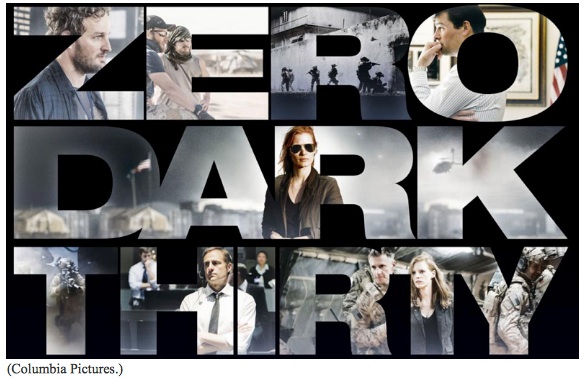
To those critics of Zero Dark Thirty who claim the film misleads the public on the role that waterboarding and other torture played in the hunt for Osama bin Laden, I suggest they look forward to the making of some other film that represents their ideals rather than make Zero Dark Thirty their scapegoat for the many conflicting and misinformed statements issued by American policy makers concerning the use of torture (I will not here legitimize the misleading euphemism "enhanced interrogation techniques") during the War on Terror. Yes, the use of waterboarding and other means of torture should be condemned by all civilized nations. But we should not be so quick to hoist our moral indignation onto a fictional film that was in the works long before the circulation of information regarding the interrogation techniques that decisively led to the discovery of Osama bin Laden in Abbottabad, Pakistan -- and that I will show did include waterboarding.
It is time that U.S. officials do more than admit that the parties responsible for the discrepancies between the film Zero Dark Thirty and the facts of the real interrogations are not the film's screenwriter and director. The discrepancies are the direct result of the contradictory messages sent by the Clinton, Bush and Obama administrations, the Department of Defense, the CIA and FBI, and successive Senate Intelligence Committees to the American public. In short, the film reflects the changing face of politics precisely as the best art should. And as for the debate ensuing over the use of torture by U.S. interrogators, that too is a positive effect of the film, especially as it may yet bring to the surface the shadowy officials past and present who advocated waterboarding and other physically coercive means of intelligence gathering throughout the War on Terror.
The protest of officials and critics against Zero Dark Thirty is largely centered around one controversy: whether or not waterboarding or any other physically and mentally coercive interrogation technique used by the CIA had succeeded in procuring information leading to the whereabouts of Osama bin Laden. The film's most impassioned and otherwise well-informed critics of the film, director Alex Gibney, The New Yorker's Jane Mayer, and CNN.com's Peter Bergen all are under the impression that no vital information had been secured by torture. The same opinion is being voiced by U.S. Senators Dianne Feinstein (D-Calif.), Carl Levin (D-Mich.), and John McCain (R-Ariz.), who together represent the Senate Intelligence Committee that last week took a hard stand against Zero Dark Thirty and Columbia Pictures for its "misleading" depiction of information obtained from captured Al Qaeda operatives as the result of waterboarding and other means of humiliation and extreme physical duress.
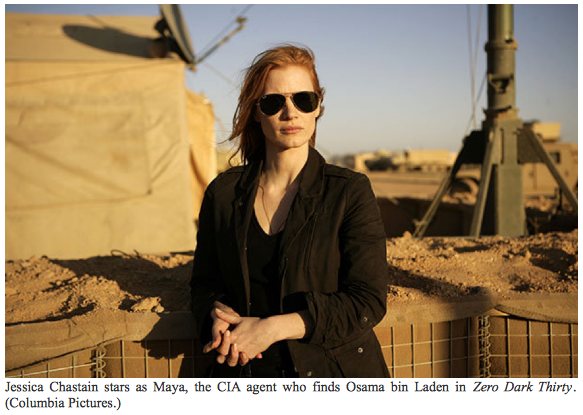
But the news archives tell us otherwise. On May 5, 2011, three days after the alleged death of Osama bin Laden, Leon Panetta, then still the CIA Chief, in an interview with NBC News anchor Brian Williams, confirmed that "enhanced interrogation techniques were used to extract information that led to the mission's success." Panetta went on to explain that waterboarding was among the techniques used and was used successfully. The only difference between Panetta's statement and the film is that bin Laden's courier is not identified in the NBC interview as the lead to the compound in Abbottabad, Pakistan where Obama was allegedly killed. Panetta also made clear that the CIA, "had a multiple series of sources... that provided information with regards to the situation. Clearly some of it came from... the interrogation of detainees but we also had information from other sources as well."
The former CIA chief is not the only official to corroborate the scene from Zero Dark Thirty in which an imprisoned al Qaeda operative discloses the name of bin Laden's courier. The same NBC dispatch examining the legalities of the raid that allegedly led to the death of bin Laden contains this quote from Representative Peter King (R-N.Y.) who was the House Homeland Security Chairman: "The road to bin Laden began with waterboarding." King then went on to state that waterboarding is a "moral imperative" that "saves lives."
Fast forward to December 2012 and ask, why would the Intelligence community and the Senate Intelligence Committee now change its story? One answer is that since Panetta and King made their disclosures to NBC in 2011 in May 2011, the intelligence community could have come to recognize that an overt admission that waterboarding or other internationally illegal means of procuring information about bin Laden's whereabouts could also make the action that the U.S. took against bin Laden illegal.
Of course, secrecy must also be excused regarding any national security issue, especially one as imperative as the hunt for Osama bin Laden. In retrospect the breech of secrecy in the first days after the raid in Abbottabad may be accounted for as mere bravado, an ill-thought out act of hubris in a gleeful week of self-congratulation. Whatever the reasons for the current retractions of Panetta and King's statement by the media and the Senate Intelligence Committee, such retractions of official statements cannot extend to the work of artists and entertainers devoid of governmental accountability. Panetta and King made statements that legitimize the scene in Zero Dark Thirty whereby bin Laden's courier is identified after the combined use of torture, extreme humiliation, and subsequent acts of camaraderie that together procured the information sought. But considering that Bigelow and Boal have made a work of fiction that they insist blindly mirrors actual events, even with the guidance of intelligence officials, even if there was not corroboration of their torture scenes by intelligence or government officials, Bigelow and Boal should not be held responsible for the disarray and contradictions of official statements to the press.

The government's withholding of strategic information will always ignite the imaginations of artists engaged in making fictional art and entertainment, and it is entirely hypocritical for Senators to come forward with accusations about the deficiencies of a work of art when it is their own collective mixed messages sent out for nearly two decades that have seen to it that such misinformation and disinformation became disseminated through art and entertainment. Even when considering the disclosures of the last year as to what kinds of interrogations proved most productive in the War on Terror, records of the facts represented in recent media reports and on the Internet are still largely obscure and contradictory. With the history of the Bush-era interrogations particularly murky and inclined toward torture, the Senate Intelligence Committee and the journalists siding with them appear to be shirking the responsibility that is theirs for continuing to disseminate the misinformation that entered the public discourse, including the arts, between 2001-08.
It's true that Zero Dark Thirty's director, Katherine Bigelow, and it's screenwriter, Mark Boal (both of whom are also the film's producers), oversimplified the depictions of torture in relationship to less coercive and physically abusive techniques available to interrogators. But for the filmmakers not to have done so would have mired the film in even more conflicting and divisive ethics and politics, the kind that keep liberals and conservatives in Congress at a perpetual standoff and leaving the more salient issues of the film from ever having gotten off the ground. In fact, the filmmakers' best defense is that the film is not a simulated documentary, not even a docudrama, in the usual sense that a docudrama follows the facts, however liberally. Zero Dark Thirty cannot be a docudrama in the strictest sense for the simple reason that the facts required for clarity are still not known outside the coterie of intelligence officials and interrogators, Senators, and the presidential administrations involved in the deployment of antiterrorist measures.
It is the severe deficiency of public knowledge concerning the everyday workings of the War on Terror that makes the fictionalization in Zero Dark Thirty not only defensible but necessary for filling the voids in the public's knowledge required to follow a story about intelligence gathering. Intelligence gathering has always been the filler for fictions involving espionage and military maneuvers. What makes the case of Zero Dark Thirty different in the minds of its critics is the film's closeness to the real intelligence agents, terrorists, informers and its portrayal of a potentially illegal international incident that incriminates officials in the United States government.
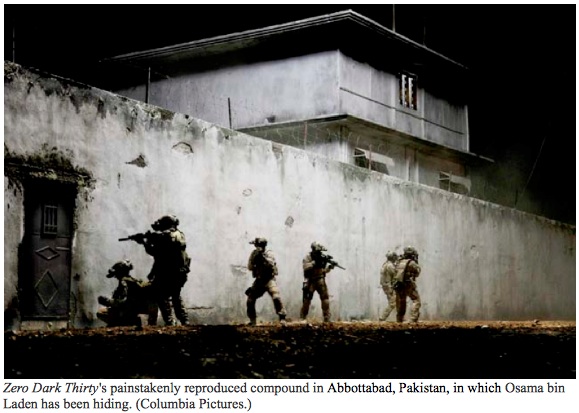
Another problem with the charges that the critics, along with the Senate Intelligence Committee, are leveling against the filmmakers, is that all are revealing themselves to being better informed than Bigelow and Boal were while writing and planning out the making of Zero Dark Thirty over the past five or so years. They are certainly better informed than Bigelow and Boal were when they had to update their filming upon receiving the news of the Abbottabad raid on May 2, 2011. Mayer, Bergen and Gibney in fact base their criticism on details since released by the Senate Intelligence Committee's study of the CIA's Detention and Interrogation Program, which entailed more than six million pages of records from the Intelligence Community -- presumably most of which were not available to Bigelow and Boal throughout their filming.
While it is known that Pentagon official Michael Vickers relayed information concerning al Qaeda intelligence gathering to Bigelow and Boal, the Pentagon has insisted that all the material was unclassified, in contrast to the classified material that the Senate Intelligence Committee holds. In essence the Senate Committee is complaining that Zero Dark Thirty doesn't correspond with the classified material they hold, when it neither could nor should correspond. Then again, most of the public doesn't know what parts of the film corresponds to real classified events and what doesn't, making the Committee's protests more alarming than the film's fictionalized account.
Since Gibney proclaims Bigelow and Boal to be "irresponsible," he might benefit from considering what responsibility during wartime requires -- for instance, that human responsibility must be conditioned on the knowledge of one's own limits. We have to know our limits to know what we as individuals can and can't do, in essence what we are and aren't responsible for, and thereby free to act on. It follows that in not knowing the limits imposed on interrogators with regard to their recourse to torture, Bigelow and Boal as artists are not only acting responsibly in resorting to fictitiously shading in the empty spaces between known CIA activities and the fragmented information released officially by both the Bush and the Obama administrations. The filmmakers are also made more responsible by representing the Bush and Obama administrations precisely as those administrations had represented themselves at the times of their press conferences. Which translates to the American policy on coercive interrogation methods being decidedly pro-waterboarding under Bush-Cheney, and famously anti-waterboarding under Obama-Biden.
If we hold to the standard of the limits of knowledge determining our responsibility in action and in art, then the limits to Bigelow and Boal's knowledge regarding the use of torture can be seen as severely restricted by the presidential administrations and the intelligence community, at least if Bigelow and Boal are telling us the truth that they received no classified information regarding the details of the search for bin Laden and his alleged death.
As for the film's introductory statement that Zero Dark Thirty is based on firsthand accounts, until we know whose accounts they were, we have plenty of reason to believe that that someone willing to talk to Boal -- such as the Pentagon's Michael Vickers, or the still-nameless Navy Seal reputed to have made disclosures about the bin Laden raid in Abbottabad -- had considered the torture being conducted by the CIA under the behest of Bush-Cheney-Rumsfeld to be advantageous, if not directly leading to essential disclosure of names and locations. We should be very concerned with this likelihood, as it suggests that the official reports being released by the Senate Intelligence Committee of late may not be entirely accurate. Or even that the Committee itself is not being frank out of concern for the ramification of what would be perceived as one government's illegal activity in a foreign state. But going to such extremes in the defense of a film is unnecessary, especially when considering the severely limited knowledge that Bigelow and Boal had to work with -- and which mirrors our own limited information today.

All things considered, the critics and Senators opposed to depictions of waterboarding and other coercive means of interrogation in Zero Dark Thirty are overreaching their duties as journalists and legislators by demanding that the filmmakers and their distributors "correct" their film -- even though the Panetta and King disclosures assure us that it is Bigelow and Boal who are correct, and not the Senate Intelligence Committee nor the journalists Mayer, Bergen and Gibney. But even if Bigelow and Boal were the ones responsible for the discrepancies between the intelligence community's activities and their depictions of that community in their film, their responsibility as artists is only to their art, not to the intelligence community or the government. The confusion lies within the journalists and the Senators who see the responsibility of artists to be the same as their own responsibilities. But the artist's responsibility is not akin to those of the journalist or the Senator, whose commitment to the public is to report, or to legislate, morally. Yes, it would be good if the artist were morally and politically on the high road -- and Bigelow and Boal are. But there is no requirement that art be honest, which is why Plato banishes the poets from his republic.
As for their moral outrage over the film, much of it is based on discrepancies of timing. Even if the Panetta and King admissions that waterboarding did lead to intelligence on bin Laden's whereabouts were somehow refuted, the journalists don't take timing into consideration. Peter Bergen wrote that the filmmakers don't "address the fact that eight months ago, the chairman of the Senate Intelligence Committee had publicly stated that, based on an exhaustive investigation, there was no evidence that coercive interrogations helped lead to bin Laden's courier." But Bergen apparently doesn't realize that that eight-months period occurs after Zero Dark Thirty is already in post-production, while it was being shot months before the results of the Committee's exhaustive study had been released. Bergen also doesn't seem to take into consideration how the official story on torture shifted within the Bush administration as public dissent was voiced against the waterboarding defended by Secretary Rumsfeld and Vice President Cheney, and of course the major policy shift that accompanied the transfer of power to the Obama administration in 2009. Considering that the scenes of torture early in the film take place under the Bush administration's tenure, the prevailing view that waterboarding and other coercive means were being employed according to the Bush-Cheney-Rumsfield world view are entirely justified, especially as conflicting accounts concerning the CIA's interrogation methods during this period obscure the facts. Zero Dark Thirty even makes it clear that the coercive means of interrogation ceased with the incoming Obama administration in 2009.
With so many of the details regarding the interrogation of captured al Qaeda operatives and their associates and the role in the search for bin Laden being hazy at best, it is the public and the media that now face the responsibility of describing the film correctly. Which means we would do well by calling Zero Dark Thirty NOT a docudrama, but a specudrama, insofar as so many of the lacunae in the information released to the public by the Obama administration, the CIA, and the Senate Intelligence Committee has been fictitiously filled in by Bigelow and Boal as it should be in a declared fictional account written amid a smokescreen of disinformation and denial. And then there is the not-so-small matter that the film isn't really about Osama bin Laden or even the means by which he is found. It's about a woman who has the fateful confluence of conviction, placement, fortitude and luck to find Public Enemy Number One. That bin Laden was allegedly found and killed by real operatives like her is a matter largely of coincidence with the writing that Boal had done months, even years before.
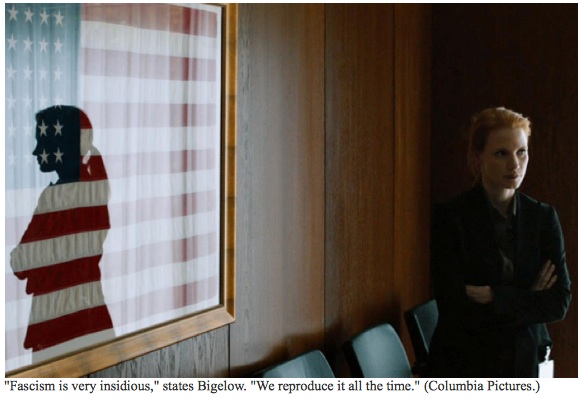
That's not to say that Zero Dark Thirty is without moral and political implications. It is filled with them at every step and turn -- including the scenes of waterboarding and other coercive methods of interrogation. What the filmmakers decline to do -- yet what their critics demand of them -- is deduce for the viewer what the final judgments regarding torture should be. Instead, Bigelow and Boal allow us the room to make our own inferences as to what is right and wrong. The end product will inevitably be a variance of opinions that put the judgements of its audience at odds with one another. But that is what the art of democracies are supposed to do -- allow us our diverse opinions even when they lead to discord. And that is the reason that both The Hurt Locker and Zero Dark Thirty avoid the pitfalls of propaganda that the film's critics and the Senate Intelligence Committee seem to be calling for.
The critics of Zero Dark Thirty's torture scenes, both those liberals who find such scenes withholding moral criticism and those conservatives who find them deficit of the patriotism that in their eyes justifies and perpetuates torture, would have the filmmakers filter, even direct, their audience's views. Anyone who sees Bigelow and Boal's refusal to make their film a denunciation of torture to be tantamount to caving in to either Senatorial grandstanding or the Hollywood bottom line would benefit by remembering that we cannot as liberals defend an art that makes our ethical and political decisions for us without opening the door of art and entertainment to the manipulations of all manner of control, including those engineered in the name of fascism.
To answer Jane Mayer's question posed in The New Yorker, "Can torture really be turned into morally neutral entertainment?" My answer is, there is no morally neutral entertainment. But there is entertainment that allows the intelligence of the viewer to work out his and her own moral dilemmas concerning how we are to respond to the scenes streaming before us.

Bigelow in 2009 went on record in an interview with the New York Times' Manohla Dargis concerning her aim as a filmmaker of exposing how "fascism is very insidious, we reproduce it all the time," not merely on the extreme right or left. It is Bigelow's curtailment of her own manipulative impulses that resonates with the restraint that we read throughout Zero Dark Thirty. In this viewer's opinion, it is such vigilance against audience manipulation that both keeps Bigelow's films buoyantly above the majority of Hollywood productions and excuses her lapses from the so-called facts concerning the CIA's use of torture, especially given that the facts were by and large not presented to the film's writer and director to begin with.
No doubt you have noticed that I have throughout this feature used the words "alleged" bagging and "alleged" assassination or death of bin Laden. I do so not because I imagine there to be some conspiracy in falsifying the identification of bin Laden's body, but because there has been virtually no scrutiny by the media of the Obama administration and the CIA over the disposal of bin Laden's body at sea without allowing representatives of the public to view the individual shot and seized by Navy Seals. It has always struck me as unusually credulous of the media, of Americans, and of the various heads of state and governments around the world, to have accepted the death of Osama bin Laden on no more than the word of a few dozen or so witnesses to his demise, most of whom remain shadowy figures to the public -- and with so little dissent over the absence of proof concerning the legitimacy of the DNA collected; the body weight and height of the corpse; the facial resemblance; the identification by bin Laden's "wife;" none of which was presented for the scrutiny of the public.
Let me state that I am to be counted among those who believe that Navy Seals did kill bin Laden on May 2, 2011 in Abbottabad. But I believe not out of some benign generosity of trust in my government -- which has been known before to misinform its citizens during wartime in the name of national security. I believe because I, like so many Americans, want the entire episode of 9/11 and our demand for retribution for the lives of the nearly 3,000 Americans lost to come to a quick and final culmination. How else are we as a nation to move forward after twelve years? To leave Afghanistan in good conscience? To initiate and carry on negotiations with our former foes? The problem is that uncertainties linger even when they seem not to, and such uncertainties left unstated in the public consciousness over whether or not it was bin Laden who died in Abbottabad, risks growing septic in the body politic both at home and abroad -- especially as al Qaeda would likely flourish with any false corroboration of bin Laden's demise.
Still, for this writer, such a void in evidence and debate coupled with so generous a credulity on the part of the global media and their audiences makes for the far bigger controversy conveyed in the film -- a controversy potentially far bigger than the accuracy of scenes containing displays of waterboarding, confinement, and dog-leashing of detainees. At least for this viewer, the real accomplishment of the film is the ambiguity with which Bigelow and Boal depict bin Laden's assassination and the transport of his corpse. Instead of alluding to the domestic and international conferences that the Obama administration orchestrated to decide on how to dispose of bin Laden's body once the president and his secretaries were satisfied it was properly identified, Bigelow and Boal underlined the disproportion between the meager evidence for bin Laden's death and the expansive credulity of the global audience when they refuse the audience anything but the most oblique view of bin Laden's corpse.
This too is in keeping with the prerogatives of fiction writing and filming, but in this case the reflection of blatant uncertainty greeted with unwarranted yet widespread credulity casts a long shadow on the real history that transpired on May 2, 2011. The darkness implied by Bigelow and Boal's film title in this instance is more than a reference to the 30 minutes past the dark of midnight that Navy Seals allegedly bagged bin Laden. The darkness is more than just another Hollywood infatuation with the ominous and existential chiaroscuro of the mind. More even than the cinematic shadows that keep special effects both within studio budgets and visually believable onscreen. The darkness of political and security interest keeps an international audience from demanding more proof of bin Laden's death, while the charisma of Barack Obama suspends our disbelief long enough to watch an assassination onscreen that appears more gratuitous than meritorious, and withholds even a momentary inspection of the bin Laden corpse onscreen.
In this light, Bigelow and Boal have made clear that there is an overt contrast between how badly our government and its intelligence wanted bin Laden found, yet never made it clear over the decade of his manhunt whether they preferred him brought back alive or dead. Bigelow and Boal wisely offer us no clear explanation as to why bin Laden ended up dead, while making it eminently clear that they believe the Navy Seals did anything but bungle the mission in killing him. Yet the wide berth they give to ambiguity in the final scenes of the alleged death and identification of bin Laden at the same time leaves open much room for doubt concerning both whether the al Qaeda leader could have been brought back alive and whether his corpse had been properly identified with every means available.
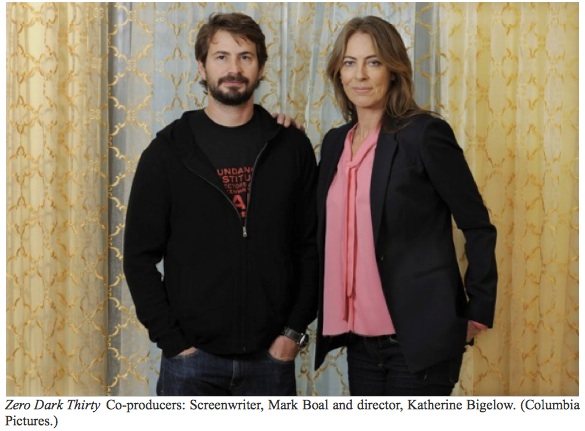
It is unlikely that any serious discussion will ensue regarding the filmmakers' ambiguous handling of the final scenes so long as the film remains a lightning rod for criticism over its early scenes of CIA torture of al Qaeda detainees. Instead of asking questions about why American Navy Seals assassinated bin Laden, we are getting bogged down with an argument of what should and shouldn't have been filmed, which is never an argument meant to be resolved by anyone other than the artists who filmed it.
This post was updated by the author on 12/25/12.
Read other posts by G. Roger Denson on Huffington Post in the archive.
Follow G. Roger Denson on Facebook and Twitter.
?
?
?
Follow G. Roger Denson on Twitter: www.twitter.com/GRogerDenson
"; var coords = [-5, -72]; // display fb-bubble FloatingPrompt.embed(this, html, undefined, 'top', {fp_intersects:1, timeout_remove:2000,ignore_arrow: true, width:236, add_xy:coords, class_name: 'clear-overlay'}); });
Source: http://www.huffingtonpost.com/g-roger-denson/zero-dark-thirty-defendin_b_2357702.html
iona taylor allderdice mixtape andrew bogut pi day monta ellis wiz khalifa taylor allderdice mixtape reggie wayne
No comments:
Post a Comment
Note: Only a member of this blog may post a comment.